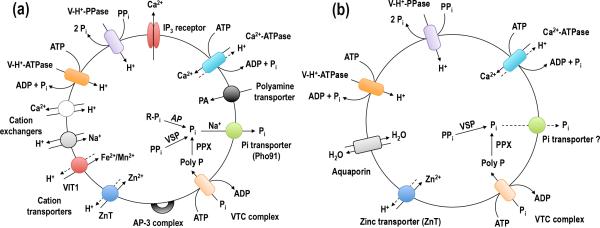Figure 2.
Schematic representation of the acidocalcisomes of T. brucei and T. cruzi. (a) In the T. brucei acidocalcisomes, Ca2+ is taken up by a H+-countertransporting Ca2+-ATPase and released by the inositol 1,4,5,trisphosphate (IP3) receptor. H+ is pumped in electrogenically by either the V-H+-PPase or the multisubunit V-H+-ATPase. Ca2+/H+ and Na+/H+ exchangers could be used for Ca2+ release in exchange for Na+ uptake. A vacuolar iron transporter (VIT1) can be used for either Mn2+ or Fe2+ uptake and a Zn2+ transporter (ZnT) for Zn2+ uptake. There is also a polyamine (PA) transporter. A VTC with at least two subunits (Vtc1 and Vtc4) synthesizes polyphosphate using ATP and translocates it into the organelle. A Na+/Pi symporter (Pho91) releases Na+ and Pi from acidocalcisomes. Within acidocalcisomes there is a vacuolar soluble pyrophosphatase (VSP), an exopolyphosphatase (PPX) and an acid phosphatase (AP). Several adaptor protein 3 (AP-3) complex subunits also localize to the acidocalcisome. (b) In the acidocalcisomes of T. cruzi, there is also an aquaporin that allows water transport, but there are fewer channels, transporters, exchangers or enzymes identified thus far.

